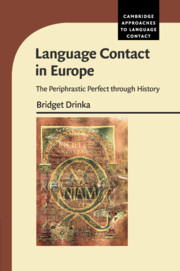Book contents
- Frontmatter
- Contents
- Series Editor's Foreword
- Acknowledgments
- Abbreviations, Based on the Leipzig Glossing Rules
- 1 Language Contact in Europe: The Periphrastic Perfect through History
- 2 Languages in Contact, Areal Linguistics, and the Perfect
- 3 The Perfect as a Category
- 4 Sources of the Perfect in Indo- European
- 5 The Periphrastic Perfect in Greek
- 6 The Periphrastic Perfect in Latin
- 7 The Charlemagne Sprachbund and the Periphrastic Perfects
- 8 The Core and Peripheral Features of the Romance Languages
- 9 The Early Development of the Perfect in the Germanic Languages
- 10 The Semantic Shift of Anterior to Preterite
- 11 The Balkan Perfects: Grammaticalization and Contact
- 12 Byzantium, Orthodoxy, and Old Church Slavonic
- 13 The l- perfect in North Slavic
- 14 Updating the Notion of Sprachbund: New Resultatives and the Circum- Baltic “Stratifi ed Convergence Zone”
- 15 The have Resultative in North Slavic and Baltic
- 16 Conclusions
- Notes
- Bibliography
- Index
10 - The Semantic Shift of Anterior to Preterite
Published online by Cambridge University Press: 23 February 2017
- Frontmatter
- Contents
- Series Editor's Foreword
- Acknowledgments
- Abbreviations, Based on the Leipzig Glossing Rules
- 1 Language Contact in Europe: The Periphrastic Perfect through History
- 2 Languages in Contact, Areal Linguistics, and the Perfect
- 3 The Perfect as a Category
- 4 Sources of the Perfect in Indo- European
- 5 The Periphrastic Perfect in Greek
- 6 The Periphrastic Perfect in Latin
- 7 The Charlemagne Sprachbund and the Periphrastic Perfects
- 8 The Core and Peripheral Features of the Romance Languages
- 9 The Early Development of the Perfect in the Germanic Languages
- 10 The Semantic Shift of Anterior to Preterite
- 11 The Balkan Perfects: Grammaticalization and Contact
- 12 Byzantium, Orthodoxy, and Old Church Slavonic
- 13 The l- perfect in North Slavic
- 14 Updating the Notion of Sprachbund: New Resultatives and the Circum- Baltic “Stratifi ed Convergence Zone”
- 15 The have Resultative in North Slavic and Baltic
- 16 Conclusions
- Notes
- Bibliography
- Index
Summary
Introduction
In Chapter 1, a stratified depiction of the expansion of the perfect across Western Europe was sketched, and in Chapter 7, the stages of this development were laid out. In this chapter, we focus on the third stage of this chronology:
III Within the HAVE / BE area, anteriors began to take on preterital value. First witnessed in the vernacular of twelfth-century Paris and its environs, it spread to areas influenced by French culture, such as western and southern Germany and northern Italy, and eventually into contiguous areas such as the Slavic territories under the rule of the Habsburgs.
In Chapter 3, the shift of Anterior > Preterite was examined in light of claims by Bybee, Perkins, and Pagliuca (1994) and others that it represents a universal process, governed by such principles as source determination, unidirectionality, and universal paths (see Figure 3.1 in Chapter 3). In response to those claims, we presented evidence that, rather than being motivated by universal paths, the shift in Europe had a fairly narrow point of initiation, in and around Paris, and that it diffused first to areas within the cultural sphere of that city, and from there to contiguous areas. The similar shifts in French, German, and other varieties should therefore not be regarded as separate instantiations of the shift, but rather as the long-lasting operation of a single, widely diffused shift. This fact is well illustrated by Ternes's (1988: 340) mapping of the contiguity of the languages in the “analytic group”, which have undergone the Anterior > Preterite shift (Figure 10.1). This group includes northern French, southern German, northern Italian, Czech, Slovak, Slovenian, and northern Serbian and Croatian. The area where the Anterior > Preterite shift occurred is clearly visible in Figure 10.2.
This contiguity of the affected languages constitutes strong evidence for areal diffusion as the prime motivation for the spread of the innovation in Europe. The Slavic languages located in the vicinity of the nuclear area – Czech, Slovak, Slovenian, and northern Croatian and Serbian – follow the same pattern in using their analytic perfects (with active resultative l-participle + BE) to mark the preterite.
- Type
- Chapter
- Information
- Language Contact in EuropeThe Periphrastic Perfect through History, pp. 255 - 266Publisher: Cambridge University PressPrint publication year: 2017



